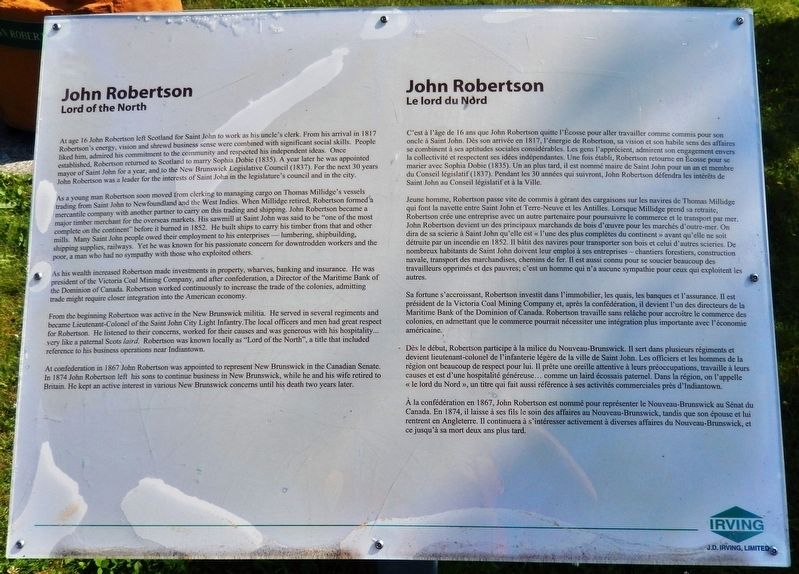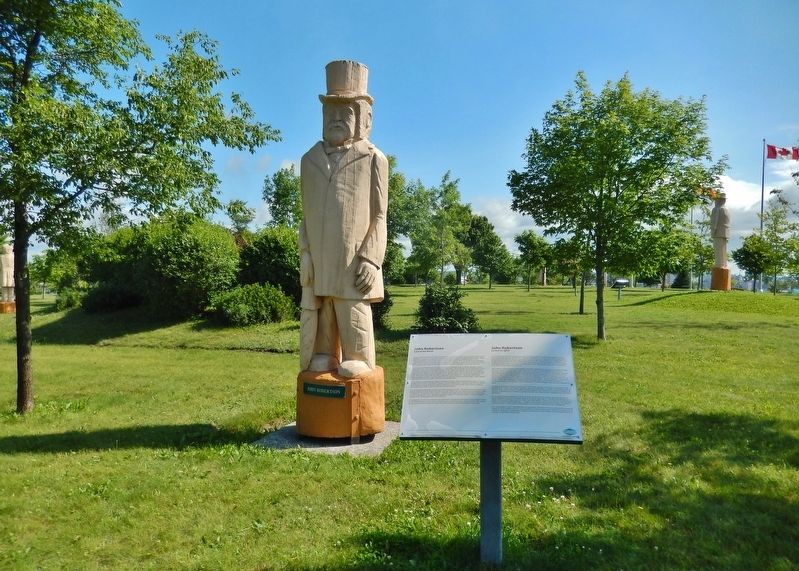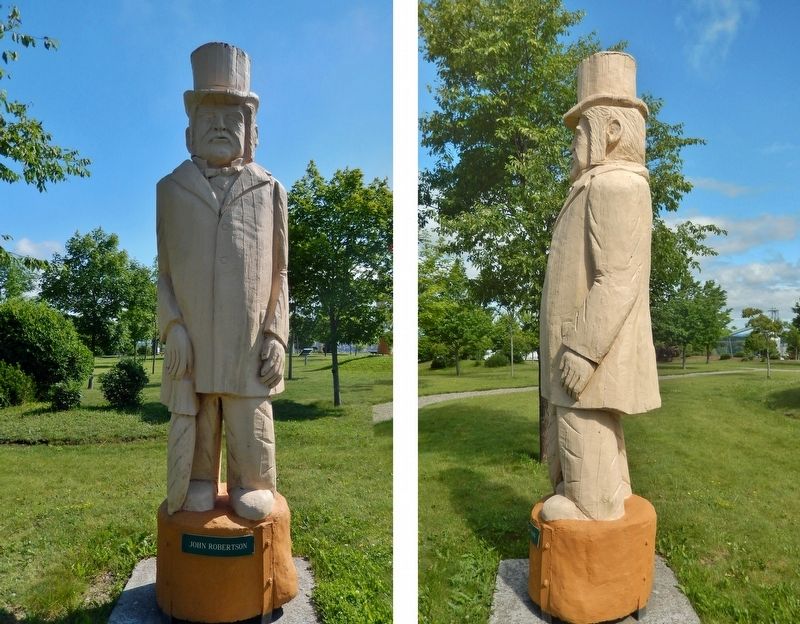Saint John in Saint John County, New Brunswick — The Atlantic Provinces (North America)
John Robertson
Lord of the North / Le Lord du Nord
At age 16 John Robertson left Scotland for Saint John to work as his uncle's clerk. From his arrival in 1817 Robertson's energy, vision and shrewd business sense were combined with significant social skills. People liked him, admired his commitment to the community and respected his independent ideas. Once established. Robertson returned to Scotland to marry Sophia Dobie (1835). A year later he was appointed mayor of Saint John for a year, and to the New Brunswick Legislative Council (1837). For the next 30 years John Robertson was a leader for the interests of Saint John in the legislature's council and in the city.
As a young man Robertson soon moved from clerking to managing cargo on Thomas Millidge's vessels trading from Saint John to Newfoundland and the West Indies. When Millidge retired, Robertson formed a mercantile company with another partner to carry on this trading and shipping. John Robertson became a major timber merchant for the overseas markets. His sawmill at Saint John was said to be "one of the most complete on the continent" before it burned in 1852. He built ships to carry his timber from that and other mills. Many Saint John people owed their employment to his enterprises — lumbering, shipbuilding, shipping supplies, railways. Yet he was known for his passionate concern for downtrodden workers and the poor, a man who had no sympathy with those who exploited others.
As his wealth increased Robertson made investments in property, wharves, banking and insurance. He was president of the Victoria Coal Mining Company, and after confederation, a Director of the Maritime Bank of the Dominion of Canada. Robertson worked continuously to increase the trade of the colonies, admitting trade might require closer integration into the American economy.
From the beginning Robertson was active in the New Brunswick militia. He served in several regiments and became Lieutenant-Colonel of the Saint John City Light Infantry. The local officers and men had great respect for Robertson. He listened to their concerns, worked for their causes and was generous with his hospitality… very like a paternal Scots laird. Robertson was known locally as "Lord of the North", a title that included reference to his business operations near Indiantown.
At confederation in 1867 John Robertson was appointed to represent New Brunswick in the Canadian Senate. In 1874 John Robertson left his sons to continue business in New Brunswick, while he and his wife retired to Britain. He kept an active interest in various New Brunswick concerns until his death two years later.
C'est à l'âge de 16 ans que John Robertson quitte l'Écosse pour aller travailler comme commis pour son oncle à Saint John. Dès son arrivée en 1817, l'énergie de Robertson, sa vision et son habile sens des affaires se combinent à ses aptitudes sociales considérables. Les gens l'apprécient, admirent son engagement envers la collectivité et respectent ses idées indépendantes. Une fois établi, Robertson retourne en Écosse pour se marier avec Sophia Dobie (1835). Un an plus tard, il est nommé maire de Saint John pour un an et membre du Conseil législatif (1837). Pendant les 30 années qui suivront, John Robertson défendra les intérêts de Saint John au Conseil législatif et à la Ville.
Jeune homme, Robertson passe vite de commis à gérant des cargaisons sur les navires de Thomas Millidge qui font la navette entre Saint John et Terre-Neuve et les Antilles. Lorsque Millidge prend sa retraite, Robertson crée une entreprise avec un autre partenaire pour poursuivre le commerce et le transport par mer. John Robertson devient un des principaux marchands de bois d'œuvre pour les marchés d'outre-mer. On dira de sa scierie à Saint John qu'elle est « l'une des plus complètes du continent » avant qu'elle ne soit détruite par un incendie en 1852. Il bâtit des navires pour transporter son bois et celui d'autres scieries. De nombreux habitants de Saint John doivent leur emploi à ses entreprises — chantiers forestiers, construction navale, transport des marchandises, chemins de fer. Il est aussi connu pour se soucier beaucoup des travailleurs opprimés et des pauvres; c'est un homme qui n'a aucune sympathie pour ceux qui exploitent les autres.
Sa fortune s'accroissant, Robertson investit dans l'immobilier, les quais, les banques et l'assurance. Il est président de la Victoria Coal Mining Company et, après la confédération, il devient l'un des directeurs de la Maritime Bank of the Dominion of Canada. Robertson travaille sans relâche pour accroître le commerce des colonies, en admettant que le commerce pourrait nécessiter une intégration plus importante avec l'économie américaine.
Dès le début, Robertson participe à la milice du Nouveau-Brunswick. Il sert dans plusieurs régiments et devient lieutenant-colonel de l'infanterie légère de la ville de Saint John. Les officiers et les hommes de la région ont beaucoup de respect pour lui. Il prête une oreille attentive à leurs préoccupations, travaille à leurs causes et est d'une hospitalité généreuse... comme un laird écossais paternel. Dans la région, on l'appelle « le lord du Nord », un titre qui fait aussi référence à ses activités commerciales près d'lndiantown.
À la confédération en 1867, John Robertson est nommé pour représenter le Nouveau-Brunswick au Sénat du Canada. En 1874, il laisse à ses fils le soin des affaires au Nouveau-Brunswick, tandis que son épouse et lui rentrent en Angleterre. Il continuera à s'intéresser activement à diverses affaires du Nouveau-Brunswick, et ce jusqu'à sa mort deux ans plus tard.
Erected by J.D. Irving, Limited.
Topics. This historical marker is listed in these topic lists: Colonial Era • Government & Politics • Industry & Commerce • Waterways & Vessels.
Location. 45° 15.4′ N, 66° 5.426′ W. Marker is in Saint John, New Brunswick, in Saint John County. Marker can be reached from Lancaster Avenue, 0.2 kilometers east of Bridge Road (New Brunswick Route 100), on the left when traveling east. Marker is located along the walking path in Wolastoq Park, near the south end of the park. Touch for map. Marker is at or near this postal address: 211 Lancaster Avenue, Saint John NB E2M 2K8, Canada. Touch for directions.
Other nearby markers. At least 8 other markers are within walking distance of this marker. Benedict Arnold (a few steps from this marker); Colonel Gabriel G. Ludlow (within shouting distance of this marker); K.C. Irving (within shouting distance of this marker); Sir Samuel Leonard Tilley (within shouting distance of this marker); William Kilby Reynolds (within shouting distance of this marker); Robert Foulis (within shouting distance of this marker); Thomas Stockwell Simms (within shouting distance of this marker); George B. Oland (within shouting distance of this marker). Touch for a list and map of all markers in Saint John.
Related markers. Click here for a list of markers that are related to this marker. Wolastoq Park
Also see . . . John Robertson. In New Brunswick Robertson was regarded as a competent and indefatigable Scot who exhibited all the hospitality and independence usually associated with the type. A letter he wrote to Samuel Leonard Tilley illustrates the point: “The taking of a man’s property without his consent, yea against his will, is a violation of his just right.” This was a firm comment on the method of government expropriation for railway purposes. (Submitted on November 2, 2019, by Cosmos Mariner of Cape Canaveral, Florida.)
Credits. This page was last revised on November 2, 2019. It was originally submitted on October 31, 2019, by Cosmos Mariner of Cape Canaveral, Florida. This page has been viewed 217 times since then and 24 times this year. Photos: 1, 2, 3. submitted on November 2, 2019, by Cosmos Mariner of Cape Canaveral, Florida.


